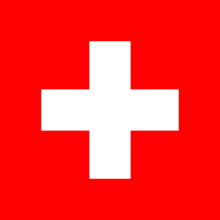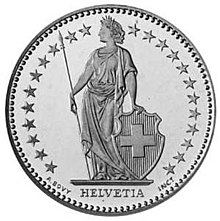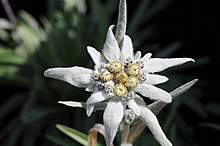National symbols of Switzerland
National symbols of Switzerland are the symbols used to represent Switzerland. As of 2020 the Swiss legislature has made three Swiss national symbols official, a flag, coat of arms, and anthem, but various other symbols are used as well to represent the Swiss people.
Official national symbols
[edit]| Symbol | Image | Notes | |||||||
|---|---|---|---|---|---|---|---|---|---|
| National flag | Flag of Switzerland |  |
[1][2] Current design in official use since 1841 | ||||||
| National coat of arms | Coat of Arms of Switzerland |  |
[3] Current design in official use since 1889 | ||||||
| National anthem | Swiss Psalm |
|
[4][5][6] Preceded by Rufst du, mein Vaterland. Officially in use since 1981 | ||||||
Unofficial national symbols
[edit]| Symbol | Image | Notes and source | |
|---|---|---|---|
| National motto | One for all, all for one (Unus pro omnibus, omnes pro uno) |  |
[7] Traditional and widespread, but not yet official. It has been recognized and used by various Swiss presidents. German: Einer für alle, alle für einen; French: Un pour tous, tous pour un; Italian: Uno per tutti, tutti per uno; Romansh: In per tuts, tuts per in. |
| National personification | Helvetia |  |
[8][9] Unofficial, but shown on the national currency and stamps |
| National flower | Edelweiss (Leontopodium nivale) |  |
[10][11] Widely accepted as the Swiss national flower. Has been used on money, rank badges, and insignia and is depicted on the logo of the national tourism organization (myswitzerland.com) |
Other Swiss symbols
[edit]Switzerland currently does not have a national animal, but the animal most commonly associated with Switzerland, or Alpine culture in general, is the cow.[12] However, various other animals have been used to represent the Swiss nation, such as the marmot, ibex, St. Bernard, and blackbird.[13][14][15] There are also a handful of cantons who use a certain animal as a symbol. These include the bear, bull, ram, ibex, lion, and eagle. Other popular Swiss symbols worth mentioning may include Swiss cheese, Swiss chocolate, Rösti, and the Swiss Army knife.
References
[edit]- ^ "Swiss flag". www.eda.admin.ch. Retrieved 2020-04-17.
- ^ "Flag of Switzerland". Encyclopedia Britannica. Retrieved 2020-04-17.
- ^ "CC 232.21 Federal Act of 21 June 2013 on the Protection of the Swiss Coat of Arms and Other Public Signs (Coat of Arms Protection, CAPA)". www.admin.ch. Retrieved 2020-04-17.
- ^ "Swiss Psalm". www.swisspsalm.ch. Retrieved 2020-04-17.
- ^ "Swiss Anthem (english)". www.about.ch. Retrieved 2020-04-17.
- ^ "Switzerland – nationalanthems.info". www.nationalanthems.info. Retrieved 2020-04-17.
- ^ Barrile. ""Einer für alle / Alle für einen" – meine 1. August-Rede". Angelo Barrile (in German). Retrieved 2020-04-17.
- ^ "Helvetia personified, Oak Leaves and Alpine Rose: How in 1875 Swiss emancipated its Franc from the French Role Model with explicit Alpine Connotation and Democratic Topics | moneymuseum.com". www.moneymuseum.com. Retrieved 2020-04-17.
- ^ "Standing Helvetia Issue of Switzerland". Mintage World. 2018-09-11. Retrieved 2020-04-17.
- ^ "What Is The National Flower of Switzerland?". WhatsAnswer. 2018-02-01. Retrieved 2020-04-17.
- ^ swissinfo.ch, Gemma d'Urso in Geneva. "The Edelweiss – Switzerland's national flower?". SWI swissinfo.ch. Retrieved 2020-04-17.
- ^ "Switzerland's iconic cow". House of Switzerland. Retrieved 2020-04-17.
- ^ "What Is the National Animal of Switzerland?". Reference. Retrieved 2020-04-17.
- ^ "Swiss Bestiary". Wall Street International. 2017-10-28. Retrieved 2020-04-17.
- ^ Misicka, Susan. "Switzerland's 'Big Four' animals on display in Zurich". SWI swissinfo.ch. Retrieved 2020-04-17.

